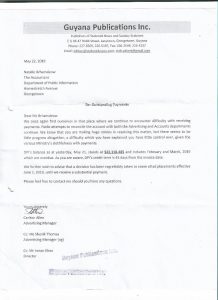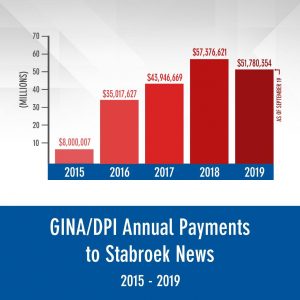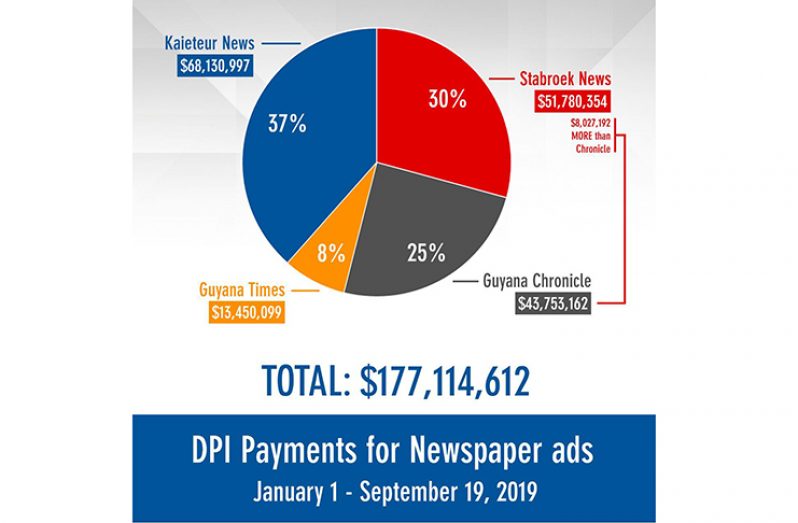…DPI exposes paper’s ‘sideline’ claims
STABROEK News, for the first nine months of 2019, received the second largest amount of state advertisements, when compared to the other three daily newspapers in the country. In fact, the records show that the privately-owned newspaper raked in $57.3M in state advertisements in 2018 when compared to $8M in 2015. Already for 2019, the newspaper has cashed in on approximately $51.7M in ads from the government.
The Department of Public Information (DPI) made the startling disclosure on Monday, as it rejected allegations by Stabroek News, that Government, in an attempt to muzzle it, has significantly cut back on advertising in that newspaper. Dubbing Stabroek News’ articles on the matter as “wholly erroneous, misleading and mischievous,” the Department of Public Information, in keeping with a commitment made, made public detailed information on the placements of ads in the local newspapers with focus on Stabroek News.
 “DPI has paid a total of $177,114,612 in newspaper advertisements payments to the four daily newspapers for the period January 1 to September 19, 2019. Of this amount Stabroek News received $51,780,354 and the state owned Guyana Chronicle received $43,753,162,” the Director of Public Information, Imran Khan, detailed. It was noted that Stabroek News has already received 29 per cent of the payments made for newspaper advertising for 2019.
“DPI has paid a total of $177,114,612 in newspaper advertisements payments to the four daily newspapers for the period January 1 to September 19, 2019. Of this amount Stabroek News received $51,780,354 and the state owned Guyana Chronicle received $43,753,162,” the Director of Public Information, Imran Khan, detailed. It was noted that Stabroek News has already received 29 per cent of the payments made for newspaper advertising for 2019.
“For 2019, Stabroek News received $8,027,192 more than Guyana Chronicle in payments,” Khan was keen on pointed out.
Though Stabroek Newspaper has complained that it has experienced a shortfall in state ads placed in its newspaper, the record shows that since the A Partnership for National Unity + Alliance for Change (APNU+AFC) Government took office, that newspaper has seen a significant increase in state ads
The Director of Public Information detailed that for the period June 1, 2015 to September 19, 2019, the Government Information Agency/Department of Public Information (GINA/DPI) paid more than $816.380M in newspaper advertising to the four daily newspapers. Of this amount, Khan said, Stabroek News received payments of $196.121M or 24 per cent.
“Under the Coalition Government GINA/DPI advertising payments to Stabroek News moved from $8million in 2015 to a whopping $57.3million in 2018,” he pointed out, while explaining that “Stabroek News was on course to an even higher figure for 2019 until it interrupted the flow of government advertising by imposing a blockade starting June 1, 2019.”
“Stabroek News impaired its own ability to receive government advertising. At no time did DPI advise Stabroek News in any manner of any intention to reduce or cease booking of advertising with the newspaper. It was the newspaper which refused to take government advertising,” Khan further clarified.
SN-imposed blockade
 The Director of Public Information made it clear that it was Stabroek News that imposed blockade on Government advertisements. DPI, he maintained, was conducting business as usual with Stabroek News without any issue, until May 22, 2019 when it received a letter from that newspaper advising that as of June 1, 2019 it will “cease all ad placements.” In support of his statement, Khan made public the letter that was sent to DPI.
The Director of Public Information made it clear that it was Stabroek News that imposed blockade on Government advertisements. DPI, he maintained, was conducting business as usual with Stabroek News without any issue, until May 22, 2019 when it received a letter from that newspaper advising that as of June 1, 2019 it will “cease all ad placements.” In support of his statement, Khan made public the letter that was sent to DPI.
“This was unprecedented and effectively resulted in Stabroek News, by its own action, and of its own free will and volition blocking government advertisements from its newspaper. DPI did not complain at the time, complied with the Stabroek News blockade and advised all government advertisers of Stabroek News’ position,” he said.
The action taken by Stabroek News is now being viewed by DPI as “high-handed, irresponsible and malicious.”
“It is now enormously strange that Stabroek News seeks to make the case that it is the government which has miniaturised advertising in the newspaper. It was the newspaper itself which stopped and blocked government from advertising in it. The reason provided by Stabroek News for blockade against government advertisements is spurious. The newspaper claimed that it was blocking government advertisements because of outstanding payments. This is ludicrous as the newspaper’s account at the time ($22,118,485) was not unusual and other newspapers have routinely had larger outstanding amounts. No newspaper has ever imposed a blockade on government advertising as a result,” the Director of Public Information said.
It was further explained that DPI effects payments to the newspapers for advertisements as monies are received from the various government ministries that use DPI to book advertisements. It was noted that the majority of the ads placed by DPI are done so on behalf of ministries and not funded from department’s budget.
“DPI served merely as a booking agent. There is a cyclical flow of payments and the accounts from time to time build up as a result of cash flow and other factors. These backlogs are cleared once funds are available and there is hardly ever a lengthy backlog of payments,” Khan further explained.
He noted too that the privately-owned newspaper also receives large volumes of advertising from some government ministries, agencies and departments that do not book advertising through DPI. Upon receiving its payments, Stabroek News then wrote DPI advising that it will resume acceptance of orders for government ads, however, by that time, DPI had already began to explore alternative avenues to placing state ads such as the use of digital media and radio advertising.
“To compensate for advertising which Stabroek News blocked, DPI began advising ministries to place and increase advertising placements with various radio stations and digital media outlets along with television stations. DPI believes that given the vast reach of both digital media and radio government is receiving greater value on these platforms,” Khan explained.
Added to that, as a result of Stabroek News’ blockade, DPI has reviewed the placement of newspaper advertising and has been advising ministries that based on all the available information, advertising in all four daily newspapers is not a mandatory or legal requirement. The requirement favours advertisements in only two print media.
Rotational placement of ads
 “DPI has advised ministries that advertisements would be placed in two newspapers – Guyana Chronicle (as the state-owned newspaper) and on a rotational basis with one of the other newspapers along with television, radio and digital media. There is a diversification of government advertising to include all media, not just newspapers. This system has commenced and as the newspaper with the widest daily circulation Kaieteur News has received the bulk of the rotation thus far. Stabroek News is included in the rotation and has been receiving advertising as outlined above,” the Director of Public Information explained.
“DPI has advised ministries that advertisements would be placed in two newspapers – Guyana Chronicle (as the state-owned newspaper) and on a rotational basis with one of the other newspapers along with television, radio and digital media. There is a diversification of government advertising to include all media, not just newspapers. This system has commenced and as the newspaper with the widest daily circulation Kaieteur News has received the bulk of the rotation thus far. Stabroek News is included in the rotation and has been receiving advertising as outlined above,” the Director of Public Information explained.
He iterated that DPI views the actions taken by Stabroek News as a heightening of the newspaper’s campaign against the government. Its regular attacks against the administration is known, he said, while alluding to the fact that Stabroek News has previously refused to accept advertisements from the Ministry of the Presidency unless the newspaper was paid up front.
“DPI has also confirmed that the newspaper had advised the Ministry of the Presidency that it is not the policy of the newspaper to publish press releases from MOTP, even though the newspaper is known to routinely publish press releases from other entities and sometimes do so unedited and in full,” Khan further pointed out.
DPI is assuring the public that there is no removal of government advertising from any newspaper. It is also maintaining that there is no evidence to support the allegation that government has been attempting to stifle the free press. “Any claims to that effect are erroneous, malicious and self-serving,” Khan stated.
He noted that Prime Minister Moses Nagamootoo, upon receiving a letter from the privately-owned newspaper, requested an explanation. That has since been provided, and has been made public.



.jpg)








